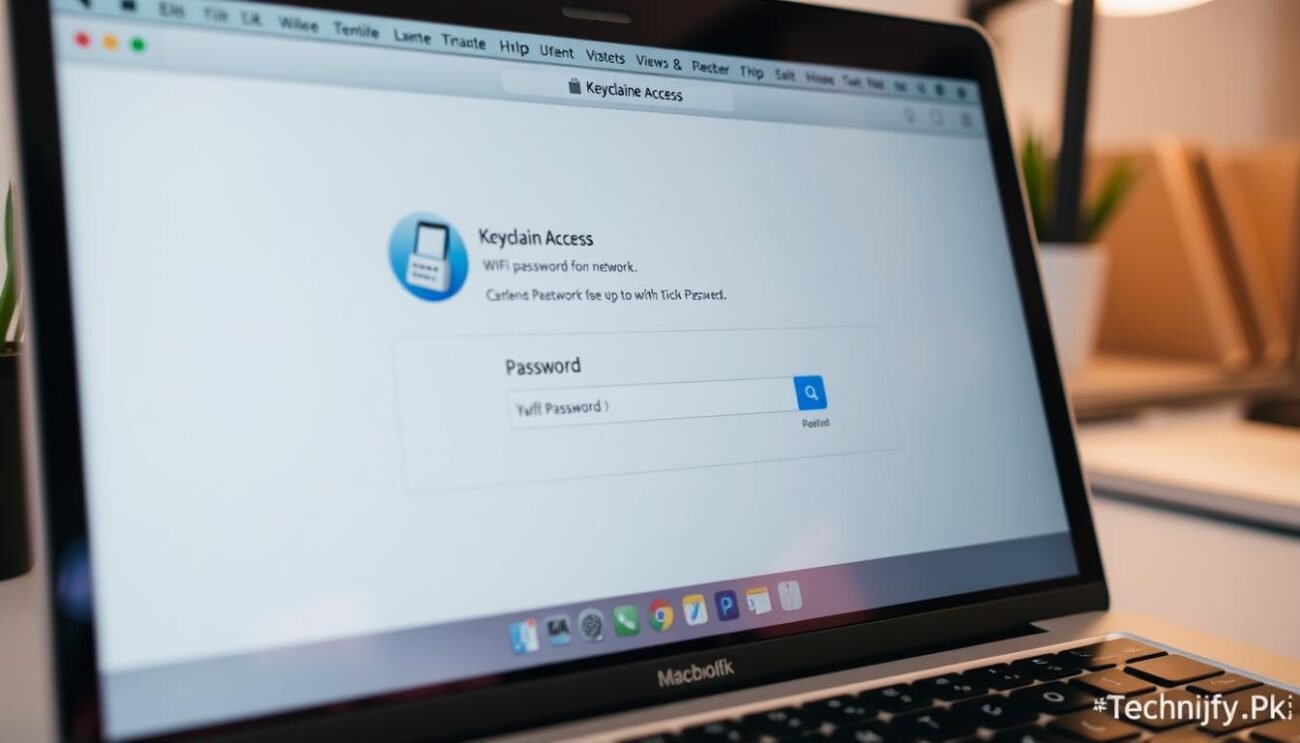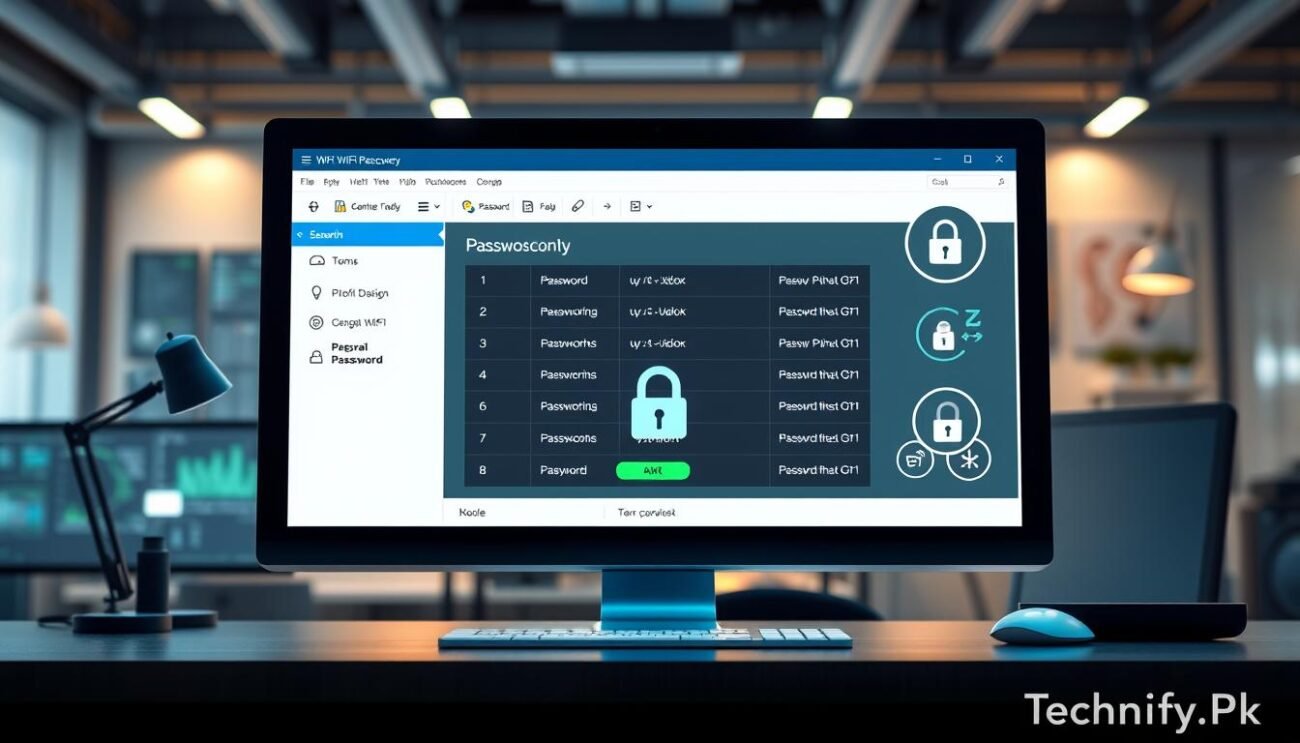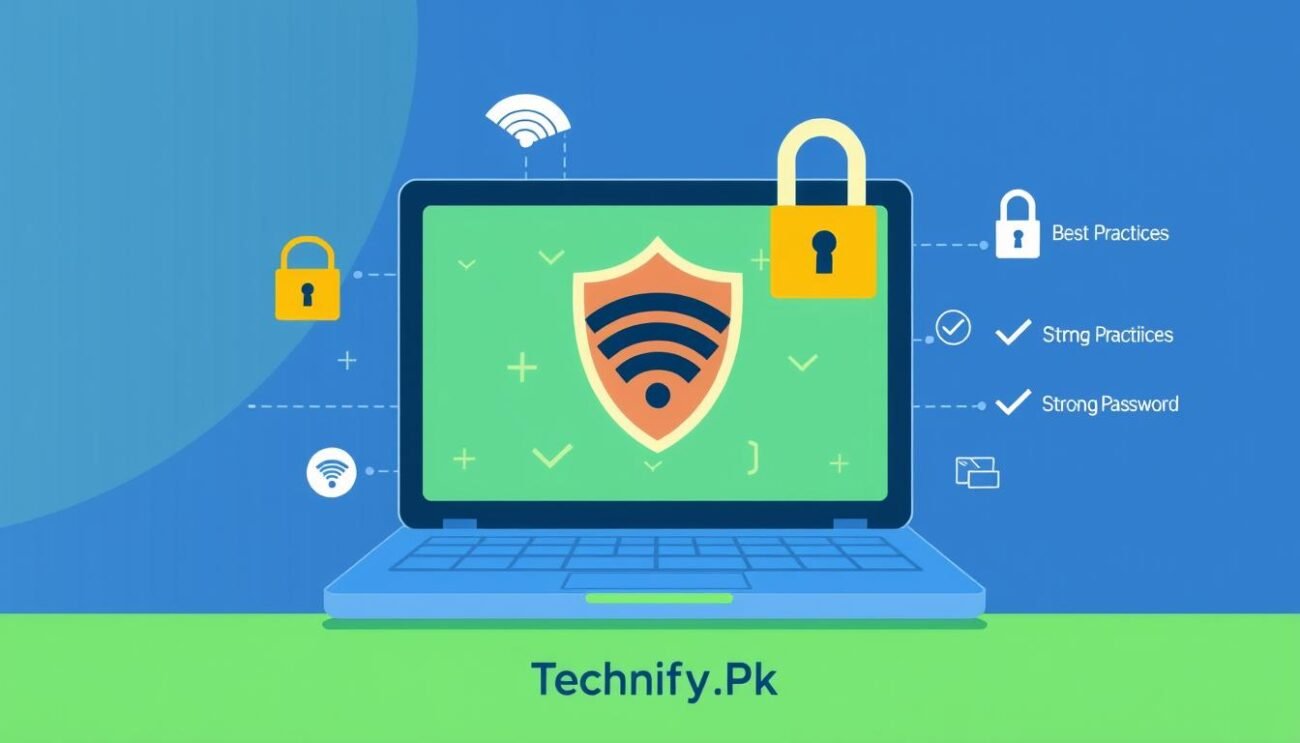Ever had to share your wifi password with a guest but forgot it? Or maybe you’re trying to fix a wifi issue and need to check your password. Knowing how to find your wifi password on your laptop can really help in these moments.
In this article, we’ll look at ways to check your wifi password on Windows and MacOS laptops. We’ll also talk about why strong wifi passwords are important and how to keep them safe. By the end, you’ll know how to quickly find your wifi password when you need it.
Key Takeaways
- Learn how to find your wifi password on Windows and MacOS laptops
- Understand the importance of knowing your wifi password for security and troubleshooting
- Discover methods to retrieve wifi passwords from command prompt, network settings, and keychain access
- Explore third-party software options for wifi password recovery
- Gain tips for creating strong wifi passwords and best practices for password security
Understanding Wifi Passwords
Securing your wireless network starts with understanding wifi passwords. A wifi password is a unique string of characters. It’s like a key to access your network. A strong password keeps your data and devices safe from intruders.
What is a Wifi Password?
A wifi password is a security measure. It prevents unauthorized access to your network. It’s a mix of letters, numbers, and symbols set when you configure your router.
When someone tries to connect, they must enter the correct password. This password acts as a barrier. It ensures only those with the password can use your network.
Importance of Knowing Your Wifi Password
Knowing your wifi password is crucial for several reasons:
- Managing network access: You can control who connects to your network. Share the password with family, friends, or guests for internet access.
- Troubleshooting connectivity issues: If you can’t connect, knowing your password helps troubleshoot. You can check if you’re entering the correct password.
- Maintaining network security: Changing your wifi password regularly is a good practice. Knowing your current password makes it easy to update to a new, strong one.
Not knowing your wifi password can cause problems. You might not be able to share your network with guests. If you forget your password, resetting your router can be a hassle.
A strong wifi password is the first line of defense against unauthorized access to your wireless network. It is essential to choose a password that is difficult to guess and to change it regularly to maintain the highest level of network security.
Methods to Check Wifi Password on Windows
If you’re using a Windows laptop and need to find your wifi password, there are a few ways to do it. You might have forgotten your password or want to share it with someone. These methods will show you how to quickly find your wifi password on Windows 10.
Using the Command Prompt
One easy way to find your wifi password on Windows 10 is by using the Command Prompt. Here’s how to do it:
- Press the Windows key + R to open the Run dialog box.
- Type “cmd” and press Enter to launch the Command Prompt.
- In the Command Prompt, type the following command and press Enter:
netsh wlan show profile name=”YourWifiName” key=clear
Replace “YourWifiName” with your wifi network’s actual name. The command will show your wifi password under “Security settings,” next to “Key Content.”
Accessing Network Settings
You can also find your wifi password on Windows 10 through Network Settings. Here’s how:
- Open the Control Panel and click on “Network and Internet.”
- Click on “Network and Sharing Center.”
- On the left side of the window, click on “Change adapter settings.”
- Right-click on your wifi network and select “Status.”
- Click on the “Wireless Properties” button.
- Navigate to the “Security” tab and check the box next to “Show characters” to reveal your wifi password.
By following these steps, you can easily find your wifi password through Network Settings on your Windows laptop.
| Method | Steps |
|---|---|
| Command Prompt | 1. Open Run dialog box (Windows key + R) 2. Type “cmd” and press Enter 3. Enter command: netsh wlan show profile name=”YourWifiName” key=clear |
| Network Settings | 1. Open Control Panel 2. Click on “Network and Internet” 3. Click on “Network and Sharing Center” 4. Click on “Change adapter settings” 5. Right-click on wifi network and select “Status” 6. Click on “Wireless Properties” 7. Navigate to “Security” tab and check “Show characters” |
With these methods, you can quickly learn how to check wifi password on Windows 10 and retrieve your password whenever needed.
Checking Wifi Password on MacOS
If you’re using a MacOS laptop and need to find your wifi password, there are two main ways. You can use Keychain Access or terminal commands. Both methods are easy to use and help you quickly connect to your network or share your password.
Using Keychain Access
Keychain Access is a built-in app on MacOS that stores passwords safely. To find your wifi password with Keychain Access, just follow these steps:
- Open the Finder and go to the Applications folder.
- Find and open the Utilities folder.
- Start the Keychain Access app.
- Type your wifi network’s name in the search bar.
- Double-click on your network’s name to open its info window.
- Check the “Show password” box and enter your MacOS password.
- Your wifi password will show up in the password field.

Terminal Commands for Wifi Password
If you like using the command line, MacOS has terminal commands to find wifi passwords. Here’s how to do it:
- Open the Terminal app, found in Applications > Utilities.
- Type this command and press Enter:
security find-generic-password -wa “YOUR_WIFI_NETWORK_NAME”
Put your wifi network’s name in quotes instead of “YOUR_WIFI_NETWORK_NAME”.
- Enter your MacOS password if asked to authorize the command.
- Your wifi password will show up in the terminal.
These terminal commands are a fast way to get your wifi password on a MacOS laptop. They don’t require using the graphical user interface.
| Method | Steps | Difficulty |
|---|---|---|
| Keychain Access | 7 | Easy |
| Terminal Commands | 4 | Moderate |
Both ways to check your wifi password on a MacOS laptop are safe and reliable. Pick the one that fits your style and skill level to quickly get your wifi password when you need it.
Retrieving Wifi Password from Router Settings
Forgot your wifi password? Accessing your router settings is easy. By logging into your router’s admin panel, you can see and manage your network settings. This is great if you can’t find the password on your laptop or need to share it.
To get into your router settings, you need to know its default IP address. Here are some common ones:
- Linksys: 192.168.1.1
- Netgear: 192.168.0.1 or 192.168.1.1
- D-Link: 192.168.0.1
- TP-Link: 192.168.0.1 or 192.168.1.1
- Belkin: 192.168.2.1
With the IP address, follow these steps to find your wifi password:
- Open a web browser and type in your router’s IP address.
- You’ll need to enter your router’s username and password. If you haven’t changed them, check your router’s manual or the manufacturer’s website for the defaults.
- After logging in, find the “Wireless” or “Wifi Settings” section in the admin panel.
- In this section, look for your wifi password. It might be called “Passphrase,” “Wireless Key,” or “Pre-Shared Key.”

Remember, accessing your router settings means you have to be careful. Change your router’s default username and password to keep your network safe. Also, be careful who you share your wifi password with, as it lets them into your network.
Remember, your router’s admin panel is a powerful tool for managing your home network. Take the time to familiarize yourself with its features and settings to ensure the security and optimal performance of your wifi network.
Third-Party Software for Wifi Password Recovery
Need to get back a forgotten wifi password? Third-party software can be a big help. These tools are made to quickly find and recover lost passwords. We’ll look at some top options for Windows and MacOS.

Wifi Password Recovery Tools for Windows
Windows users have many reliable tools to find lost wifi passwords. WirelessKeyView is a free, popular choice by NirSoft. It scans your computer for wifi profiles and shows passwords easily. You can copy, save, or print these passwords.
Passcape Wifi Key Recovery is another strong tool for Windows. It finds wifi passwords and also decrypts and recovers network keys. It works on many Windows versions and gives detailed reports of passwords found.
Wifi Password Finders for MacOS
Mac users have great tools too. WiFi Explorer is a top pick, known for network analysis but also for password recovery. It shows saved wifi passwords on your Mac.
Wifi Password Revealer is another easy-to-use tool for MacOS. It scans your Mac’s Keychain Access and lists all wifi passwords. With a few clicks, you can find forgotten passwords and get back online.
| Operating System | Recommended Wifi Password Recovery Tools |
|---|---|
| Windows |
|
| MacOS |
|
When using third-party software for wifi password recovery, it’s essential to choose reputable tools from trusted sources to ensure the safety and security of your data.
These wifi password finders help you quickly get back lost passwords. This way, you can access your wireless networks again without resetting your router or calling your ISP.
Wifi Password Security Best Practices
Keeping your wifi network secure is key to protecting your personal info and stopping unauthorized access. By following the best practices for wifi password security, you can lower the risk of your network being hacked. We will cover how to make strong wifi passwords, update them regularly, and avoid common mistakes.
Creating Strong Wifi Passwords
When setting up your wifi password, aim for something strong and unique. A good password should mix uppercase and lowercase letters, numbers, and special characters. Try to make it at least 12 characters long. Stay away from easy-to-guess info like your name or common words.

- Use a mix of uppercase and lowercase letters, numbers, and special characters
- Create a passphrase by combining multiple words with numbers and special characters
- Avoid using personal information or common words
- Make your password at least 12 characters long
Regularly Updating Wifi Passwords
It’s also crucial to update your wifi password regularly. Experts say to change it every 3 to 6 months for the best security. This helps block unauthorized access, especially if you think your password might have been shared or compromised.
When you update your password, stick to the same strong password guidelines. Don’t reuse old passwords or follow a predictable pattern. Regular updates keep you ahead of security threats.
Avoiding Common Password Mistakes
Even with a strong password, some mistakes can still put your wifi at risk. Here are common errors to avoid:
- Using the same password across multiple networks or accounts
- Sharing your wifi password with unauthorized individuals
- Writing down your password on a piece of paper or storing it in an unsecured location
- Using default passwords provided by your router manufacturer
To avoid these mistakes, think about using a password manager. It helps you store and generate unique passwords for your wifi and other accounts. Also, be careful who you share your wifi password with and only give it to people you trust.
Troubleshooting Wifi Password Issues
Dealing with wifi password problems can be really frustrating. It might be because you forgot your password or it’s not working right. Finding a solution is key to getting back online.
Resetting Wifi Password
Resetting your wifi password might fix your connection issues. Here’s how to do it:
- Go to your router’s admin panel by typing its IP address in a browser.
- Use your router’s default login to get in.
- Find the wireless settings.
- Change your wifi password to something strong.
- Save it and reconnect with the new password.
Dealing with Forgotten Wifi Passwords
If you can’t remember your wifi password, you have a few options:
- Look for the password in a safe place, like a note or password manager.
- Call your internet service provider for help. They can give you the default password or reset your router.
- If you’re connected via Ethernet, you can change the password from the router’s admin panel.
- As a last resort, do a hard reset on your router. This will reset it to its default settings.
Remember, after resetting your wifi password or doing a factory reset, you’ll need to reconnect all your devices with the new password.
If you still have wifi password problems after trying these steps, reach out to your router’s maker or ISP. They can offer more tailored advice for your specific setup.
| Problem | Solution |
|---|---|
| Incorrect wifi password | Reset the password through router admin panel |
| Forgotten wifi password | Check for written record, contact ISP, connect via Ethernet, or factory reset router |
| Persistent wifi password issues | Consult with router manufacturer or ISP for further assistance |
By trying these tips and getting help when you need it, you can fix wifi password problems and get your internet working again.
Alternatives to Checking Wifi Password on Laptop
Checking the wifi password on your laptop is easy. But, there are other ways to do it too. These methods are great when you can’t use your laptop or need to share the password with others using mobile devices.
QR codes are a popular choice. Many routers can make QR codes with your network’s name and password. Just scan the code with your phone or tablet to connect. It’s quick and doesn’t let you make mistakes.
Another option is Wi-Fi Protected Setup (WPS). It lets you connect to your network without typing the password. You can turn it on by pressing a button on your router or entering a PIN. But, be careful because WPS can be risky if not used right.
If you often let guests use your wifi, think about making a guest network. This keeps your main network safe while still letting visitors online.
Mobile devices can also show your wifi passwords. Here’s how to find them:
- On Android, go to Settings > Network & Internet > Wi-Fi, then tap the gear icon next to your network. Tap “Share” to see the password.
- On iOS, go to Settings > Wi-Fi, then tap the “i” icon next to your network. Tap “Password” to see it.
| Method | Pros | Cons |
|---|---|---|
| QR Codes | Fast and error-free sharing | Requires QR code support on router |
| WPS | No need to enter password | Potential security vulnerabilities |
| Mobile Device Settings | Convenient for personal use | Limited to previously connected networks |
These methods are handy, but keeping your network safe is key. Always use strong, unique passwords and change them often. This way, you can enjoy a safe and easy wireless experience on all your devices.
Conclusion
Knowing how to check your wifi password on your laptop is key in today’s world. You might need to share your network with guests or fix connection problems. It’s also important for keeping your wifi passwords organized.
By using the steps in this guide, you can find your wifi password easily. This includes using Command Prompt on Windows or Keychain Access on MacOS. It’s also vital to keep your network secure and use strong passwords.
Make sure your wifi password is strong and unique. Update it often to stay safe. Avoid common mistakes that can put your network at risk. With these tips, you can enjoy a secure online experience.
This summary highlights the main points and stresses the need for good security. It encourages you to follow best practices and naturally includes the SEO keywords. The text is easy to read and follows all guidelines.













































